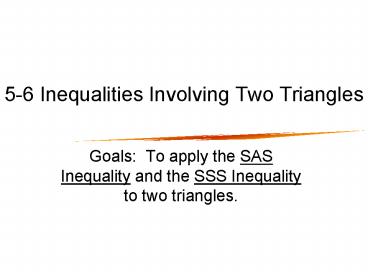56 Inequalities Involving Two Triangles PowerPoint PPT Presentation
1 / 9
Title: 56 Inequalities Involving Two Triangles
1
5-6 Inequalities Involving Two Triangles
- Goals To apply the SAS Inequality and the SSS
Inequality to two triangles.
2
Theorem 5-13 (SAS Inequality)Hinge Theorem
- If two sides of one triangle are congruent to two
sides of another triangle, and the included angle
in one triangle is greater than the included
angle in the other, then the third side of the
first triangle is longer than the third side in
the second triangle.
BC gt EF
3
Theorem 5-14 (SSS Inequality)Converse of Hinge
- If two sides of one triangle are congruent to two
sides of another triangle, and the third side in
one triangle is longer than the third side in the
other, then the angle between the pair of
congruent sides in the first triangle is greater
than the corresponding angle in the second
triangle.
?A gt ? D
4
Example 1
- Refer to the figure below to relate how each pair
of angle measures is related.
a. m ? ADC and m ? ADB
m ? ADC lt m ? ADB
b. m ? AFB and m ? BFD
m ? AFB gt m ? BFD
5
Example 2
- In ?ABC, CM is a median. Determine if the
following statement is always true, sometimes
true, or never true. - If m ? 2 lt m ? 1, then BC gt AC.
- SAS Inequality says that since ? 1 is bigger than
? 2, then BC will be longer than AC. - Always True
6
Example 3
- Write an inequality or pair of inequalities to
describe the possible values of x.
5x-14 lt 46 5x lt 60 x lt 12
5x-14 gt 0 5x gt 14 x gt 2.8
2.8 lt x lt 12
7
Steps for writing an indirect proof (paragraph
format only)
- Assume that the conclusion is false.
- Show that the assumption leads to a contradiction
of the hypothesis or some other fact, such as a
postulate, theorem, or corollary. - Point out that the assumption must be false and,
therefore, the conclusion must be true. - Read Ex.3 and 4 on pg 338 for a full proof.
8
Example 1
- State the assumption you would make to start an
indirect proof of each statement. DO NOT write
the proofs. - AB bisects ?A.
- Assume that AB does not bisect ? A.
- ?XTZ is isosceles.
- Assume that ?XTZ is not isosceles.
- m ? 1 lt m ? 2
- Assume that m ? 1 m ? 2
9
Example 2
- Identify the two statements that contradict each
other. - I. P, Q, and R are coplanar.
- II. P, Q, and R are collinear.
- III. m?PQR 60
- II and III, since P, Q, and R cannot be collinear
and form an angle other than 180.

